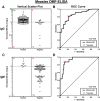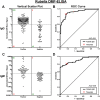Use of a rapid digital microfluidics-powered immunoassay for assessing measles and rubella infection and immunity in outbreak settings in the Democratic Republic of the Congo
- PMID: 36542608
- PMCID: PMC9770344
- DOI: 10.1371/journal.pone.0278749
Use of a rapid digital microfluidics-powered immunoassay for assessing measles and rubella infection and immunity in outbreak settings in the Democratic Republic of the Congo
Abstract
The Democratic Republic of the Congo (DRC) has a high measles incidence despite elimination efforts and has yet to introduce rubella vaccine. We evaluated the performance of a prototype rapid digital microfluidics powered (DMF) enzyme-linked immunoassay (ELISA) assessing measles and rubella infection, by testing for immunoglobulin M (IgM), and immunity from natural infection or vaccine, by testing immunoglobulin G (IgG), in outbreak settings. Field evaluations were conducted during September 2017, in Kinshasa province, DRC. Blood specimens were collected during an outbreak investigation of suspected measles cases and tested for measles and rubella IgM and IgG using the DMF-ELISA in the field. Simultaneously, a household serosurvey for measles and rubella IgG was conducted in a recently confirmed measles outbreak area. DMF-ELISA results were compared with reference ELISA results tested at DRC's National Public Health Laboratory and the US Centers for Disease Control and Prevention. Of 157 suspected measles cases, rubella IgM was detected in 54% while measles IgM was detected in 13%. Measles IgG-positive cases were higher among vaccinated persons (87%) than unvaccinated persons (72%). In the recent measles outbreak area, measles IgG seroprevalence was 93% overall, while rubella seroprevalence was lower for children (77%) than women (98%). Compared with reference ELISA, DMF-ELISA sensitivity and specificity were 82% and 78% for measles IgG; 88% and 89% for measles IgM; 85% and 85% for rubella IgG; and 81% and 83% for rubella IgM, respectively. Rubella infection was detected in more than half of persons meeting the suspected measles case definition during a presumed measles outbreak, suggesting substantial unrecognized rubella incidence, and highlighting the need for rubella vaccine introduction into the national schedule. The performance of the DMF-ELISA suggested that this technology can be used to develop rapid diagnostic tests for measles and rubella.
Copyright: This is an open access article, free of all copyright, and may be freely reproduced, distributed, transmitted, modified, built upon, or otherwise used by anyone for any lawful purpose. The work is made available under the Creative Commons CC0 public domain dedication.
Conflict of interest statement
R.F., C.F., and A.R.W. have ownership stakes in Sci-Bots Inc., which sells a commercial DropBot control system, which forms part of the customized MR Box 2 used for field trials in this study. This does not alter our adherence to PLOS ONE policies on sharing data and materials.
Figures



References
-
- WHO. Global Measles and Rubella Strategic Plan 2012–2020. https://apps.who.int/iris/rest/bitstreams/53400/retrieve.
-
- WHO. Vaccine-Preventable Diseases, Surveillance Standards—Measles. https://www.who.int/immunization/monitoring_surveillance/burden/vpd/stan....
Publication types
MeSH terms
Substances
Grants and funding
LinkOut - more resources
Full Text Sources
Medical

